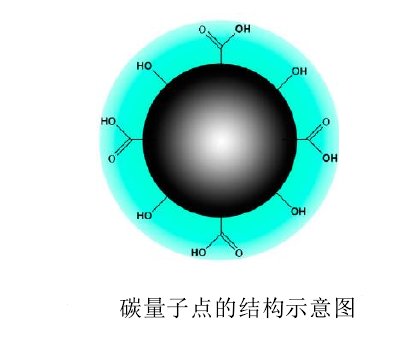 13929258449
13929258449
 13929258449
13929258449
Carbon Quantum Dots (CQDs) typically refer to monodisperse spherical nano carbon materials with a size of less than 10nm, composed of sp2/sp3 carbon core and outer oxygen/nitrogen functional groups. It has excellent performance similar to traditional semiconductor quantum dots, but can effectively overcome the defects of high toxicity and poor biocompatibility. It has a wide range of sources, is easy to synthesize, and is easy to functionalize, making it an ideal substitute material for traditional semiconductor quantum dots.
Chemical structure
Carbon quantum dots are usually spherical particles with a diameter of less than 10nm, composed of sp2/sp3 carbon clusters with amorphous or nanocrystalline structures. Research has found that the structure and physicochemical properties of carbon quantum dots can be selectively altered by introducing different surface defects, doping with heteroatoms, and functional groups.

Optical properties of carbon quantum dots
Carbon quantum dots have various excellent optical properties, such as optical absorption, photoluminescence, chemiluminescence, and electrochemiluminescence. These optical properties are the foundation for the application of carbon quantum dots in multiple fields.
Optical absorption
The π - π * transition of C=C bond enables carbon quantum dots to have strong optical absorption in the ultraviolet region and can extend to the visible light region. Some carbon quantum dots will also undergo n - π * transitions at the C=O bond. The absorption spectrum can be adjusted by introducing functional groups and surface passivation.
Photoluminescence
The quantum effects of carbon quantum dots of different sizes are caused by different emission traps on the surface, and effective surface passivation is a necessary condition for carbon quantum dots to have strong photoluminescence. Different surface passivation can achieve the desired photoluminescence performance. In addition, the photoluminescence of carbon quantum dots is also pH dependent.
Upconversion luminescence
Upconversion luminescence (UCPL) refers to the optical phenomenon in which a substance simultaneously absorbs two or more photons, indicating an emission wavelength smaller than the excitation wavelength (anti Stokes emission). Research suggests that upconversion luminescence originates from the transition from high-energy π orbitals to σ Orbital electron relaxation may be caused by leakage from the secondary diffraction part of the monochromator in a fluorescence spectrometer.
Chemiluminescence
Carbon quantum dots exhibit chemiluminescence (CL) when coexisting with MnO4- or Ce4+. The coincidence of radiation caused by electrons generated through chemical reduction and holes generated by thermal excitation is believed to be the reason for chemiluminescence.
Electrochemiluminescence
Carbon quantum dots exhibit electrochemiluminescence (ECL) properties. Under the action of voltage, the electron transfer generated by the oxidation-reduction state of carbon quantum dots annihilates, forming an excited state, which generates an electrochemiluminescence signal during the relaxation process of returning to the ground state.
Electronic transfer performance
The excited states and related transient phenomena of carbon quantum dots are related to fluorescence emission and redox processes. The performance of photo induced electron transfer (PET) is the foundation for energy conversion and catalytic applications of carbon quantum dots. Research has found that the electron transfer performance of carbon quantum dots is mainly influenced by the doping of carbon nuclei, functional groups, and heteroatoms.
Biological performance
Carbon quantum dots have significantly higher biocompatibility than other nanomaterials. Research has shown that most pure carbon quantum dots and surface passivated carbon quantum dots have no significant cytotoxicity. In a few cases, surface passivation and functionalization may lead to lower biological toxicity of carbon quantum dots.
SAT NANO is the supplier fo carbon quantum dots in China, we can offer blue and green fluorescence, if you have any interesting, please feel free to contact us at admin@satnano.com
 online service
online service 13929258449
13929258449 admin@satnano.com
admin@satnano.com led_zhiding
led_zhiding + 8613929258449
+ 8613929258449